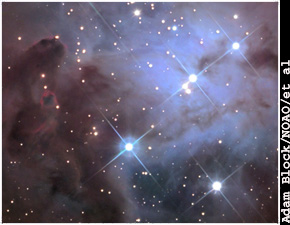As comets approach the Sun they develop enormous tails of luminous material that extend for millions of kilometers from
the head, away from the Sun. When far from the Sun, the nucleus is very cold and its material is frozen solid within the nucleus.
In this state comets are sometimes referred to as a "dirty iceberg" or "dirty snowball," since over half of their material
is ice. When a comet approaches within a few AU of the Sun, the surface of the nucleus begins to warm, and volatiles evaporate. The evaporated molecules boil off and carry
small solid particles with them, forming the comet's coma of gas and dust.
When the nucleus is frozen, it can be seen only by reflected sunlight. However, when a coma develops, dust reflects still
more sunlight, and gas in the coma absorbs ultraviolet radiation and begins to fluoresce. At about 5 AU from the Sun, fluorescence
usually becomes more intense than reflected light.
As the comet absorbs ultraviolet light, chemical processes release hydrogen, which escapes the comet's gravity, and forms
a hydrogen envelope. This envelope cannot be seen from Earth because its light is absorbed by our atmosphere, but it has been
detected by spacecraft.
The Sun's radiation pressure and solar wind accelerate materials away from the comet's head at differing velocities according
to the size and mass of the materials. Thus, relatively massive dust tails are accelerated slowly and tend to be curved. The
ion tail is much less massive, and is accelerated so greatly that it appears as a nearly straight line extending away from
the comet opposite the Sun. The following view of Comet West shows two distinct tails. The thin blue plasma tail is made up
of gases and the broad white tail is made up of microscopic dust particles.
Each time a comet visits the Sun, it loses some of its volatiles. Eventually, it becomes just another rocky mass in the
solar system. For this reason, comets are said to be short-lived, on a cosmological time scale. Many scientists believe that
some asteroids are extinct comet nuclei, comets that have lost all of their volatiles.

